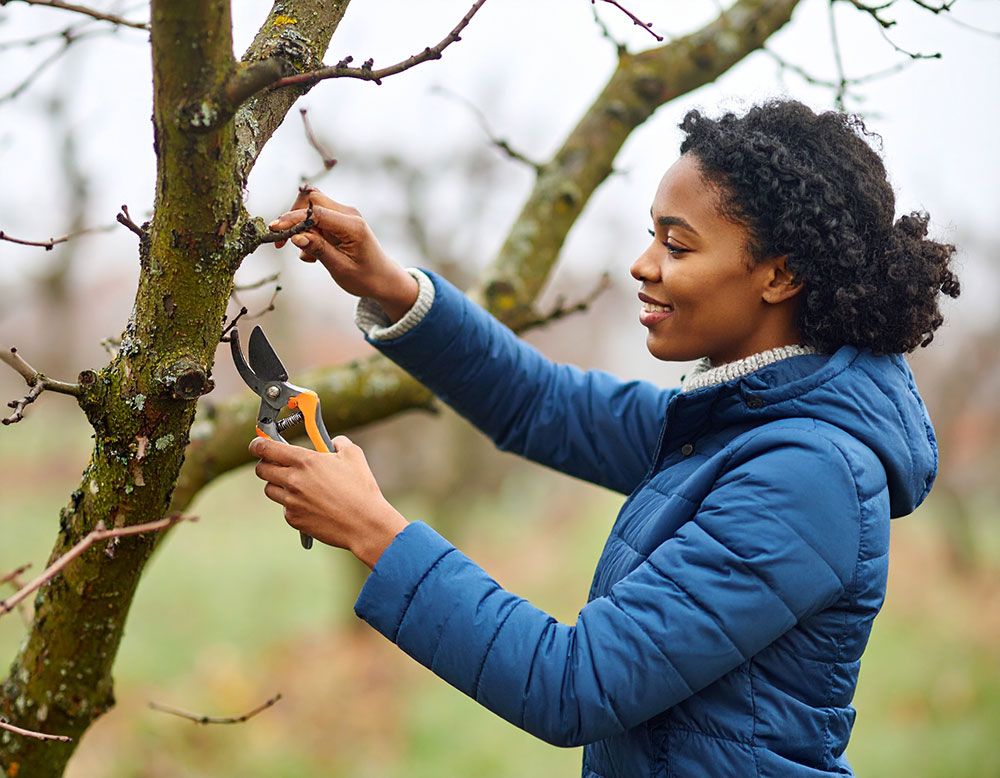How to Prune Deciduous Fruit Trees in Winter for a Healthy Summer Harvest
Pruning does more than make a tree look good–it’s important to its health. In the case of deciduous fruit trees, trimming well now will give you a good crop.
All fruit trees need proper watering and fertilizing, but the key to good production for deciduous fruit trees may surprise you. How well a tree fruits in the summer depends on how you prune it in January.
This month–while they’re dormant–is the perfect time to prune many summer-bearing fruit trees such as peaches, plums, apples, nectarines, and apricots.
“To keep a deciduous fruit tree producing good amounts of high-quality fruit on a consistent basis, it’s important to prune in January,” said James Barry, a consulting arborist in Orange. “Waiting until the tree starts to bud out is not a good idea, because this will disturb the tree’s physiology.”
The main goal of pruning is to renew or preserve fruiting wood–the wood that bears the fruit. Without healthy, well-preserved fruiting wood, a tree isn’t likely to produce well.
Importance of Proper Pruning
Bill Gelling, past president of the Foothill Chapter of the California Rare Fruit Growers, has 55 fruit-bearing trees in his Fullerton yard. He recalls the year he failed to prune an apple tree–and the resulting poor crop.
“The tree grew upright, and there was just a little fruit at the tips of branches,” he said. “When apples aren’t pruned and allowed to grow, they will grow upward and produce too much shade for fruiting. Apple tree branches actually need to be spread out for good fruit production.”
Citrus trees should not be treated the same way as deciduous fruit trees. The only pruning citrus generally require is thinning out crossing branches and removing sprouts that develop at the base of the tree.
Many deciduous trees fruit on branches that are a year or more older. For this reason, it’s important to know what you’re doing before you wield the pruning shears. Over-pruning can be just as damaging as under-pruning.
“Some fruit trees have fruiting wood that is 2 to 3 years old,” Gelling said. “If you accidentally cut off those branches, you won’t have fruit again for a few years.”
“Pruning for fruiting requires striking a balance,” said Fullerton consulting arborist Alden Kelley. “There’s an art to fruit tree pruning; you need to use logic and intuition and work with each tree according to its individual growth habits and fruit production.”
Age is also a factor. In general, in the first few years, you train a tree for form. When the tree becomes more established, you concentrate on preserving the fruiting wood.
Don’t be surprised if your pruned fruit tree doesn’t look all that attractive. “Properly pruned fruit trees tend to have a stubby, uneven look,” Barry said. This occurs because most fruit tree pruning involves heading, or cuts to shorten branches. Thinning or removing entire branches isn’t done as much because you could cut off fruiting wood.
Finding Fruiting Wood
There are three ways to find fruiting wood:
- Remember where the tree flowered and fruited the year before. Take a picture in summer for reference.
- Look for clusters of buds on branches. These will produce flowers and fruit.
- Know your specific tree. For example, peaches fruit on 1-year-old wood, while plums show bud clusters.
Basic Pruning Rules
- When shortening a branch, ensure there is a side branch one-third to one-half its diameter to take over.
- Always cut out crossing branches to prevent rubbing and disease.
- Don’t cut into the branch collar near the trunk. Leave a few inches to avoid disease and maintain water supply.
Trees that have been neglected or incorrectly pruned can be saved. “If you prune a tree slowly in stages over a couple of years and allow it to store energy, you can get a tree to fruit again,” Barry said.
Light summer pruning after fruiting also helps prevent damage and improves light access. It’s during summer that trees store energy for the following season.
Fruit Thinning
Fruit thinning is also key to a good crop:
- Peaches and nectarines: Thin fruit 8–12 inches apart when olive-sized.
- Apricots and plums: Thin 4–6 inches apart.
- Apples: Spacing depends on variety.
How to Prune Popular Deciduous Fruit Trees
Apples
Apples are the most complex to prune. Some bear on permanent short spurs. Don’t damage these spurs. Mature trees require branch spreading more than heavy pruning to promote light penetration and fruiting.
Apricots
Look for small bud clusters. Older varieties fruit on 1-year-old wood. Newer varieties may use 2–3-year-old wood. Cut above buds and head long branches just above fruiting wood.
Peaches and Nectarines
These should be pruned hardest. Remove two-thirds of new shoots and shorten the rest by two-thirds. Fruiting wood is last year’s growth.
Plums
Plums fruit on 1–2-year-old wood. Look for bud clusters. Thin out suckers growing on older wood and head back other branches just above the buds.
Additional information can be found in “How to Prune Fruit Trees” by R. Sanford Martin, available at many nurseries.

